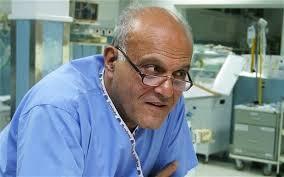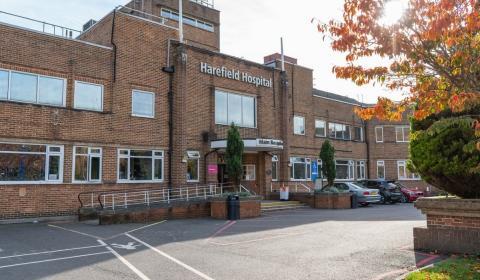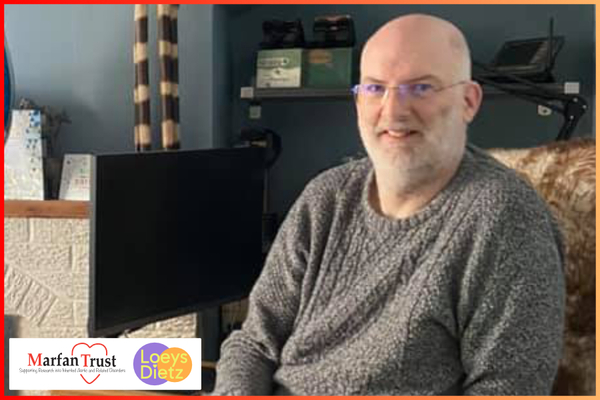Tirelessly fighting to ensure that her son didn’t face the same fate as his father, Darren’s mother was the driving force behind his Marfan diagnosis and subsequent surgery. Invented just at the right time for Darren, the Yacoub Procedure saved his life. Read his story:

by Darren
My father, John, who also had Marfan syndrome died in 1972 when I was less than a year old from what at the time was described as a heart attack, but was probably an aortic dissection. He was already being investigated for a leaking heart valve, but back then investigation tools were limited to an ECG and a stethoscope, so even with correct diagnosis the outcome would have been bleak.
A few years later my mother remarried. My step-father and especially my mother spent the whole of my childhood pushing doctors to make sure the same didn't happen to me as to my father. At the time there was no diagnosis of Marfan for either myself or my late father.
[pictured, Darren's father, John]

I was referred to a paediatrician at my local hospital at a very young age. I seemed to spend a lot of time at the hospital as they marvelled over my hypermobile joints and unusual presentation. During these early days they identified a heart murmur and took many x-rays and traditional photos that were sent to many doctors whilst trying to find a diagnosis without success at this point.
[pictured, Darren as a toddler held by his mother]

It was around 1982 when I was referred to Liverpool Heart Hospital because of the heart murmur and the lack of medical diagnosis at that point. The hospital had an echocardiogram which was in its infancy at the time and only really existed in the city hospitals. On the second visit to Liverpool my mum was asked to take a photo of my deceased father to help with diagnosis.
They eventually diagnosed Marfan syndrome after many visits and tests. This took so long as there was no internet back in the early 1980s and diagnosis relied heavily on written papers. I remember as a young 11-12 year old spending what seemed to be many hours sitting outside the consultant's office staring at the metal pipework on the ceiling of the corridor as I waited for my mother to appear from his office, where they had been discussing the heart scan findings. My mum often appeared from the room red-eyed and struggling to hold back the tears, as she had obviously been given news that no mother wants to hear.
Liverpool had diagnosed that I had an aortic root aneurysm and my aortic valve was leaking, but there was nothing they could do as aortic root grafts were not being performed anywhere at this time.
There was hope, though, as an Egyptian surgeon named Sir Professor Magdi Yacoub famed for heart transplantation, was performing some very new and revolutionary surgery at Harefield hospital in London. So I was referred to him in the hope that he could do something.

Professor Yacoub agreed to see me and I visited Harefield for the first time in 1985 where I had an echocardiography, ECG and x-ray. We then waited many hours for Professor Yacoub to see us as he was busy performing a heart transplant. He appeared, still in his scrubs, a very calm and instantly reassuring man. He took me straight back to the Echo department, where he performed another echo scan on me himself just so he could see for himself what he was dealing with.
Professor Yacoub asked me to wait outside, as I’d done many times in the past, whilst he told my parents that I needed an aortic root replacement, along with a repair to the aortic valve. He talked about the very high chance of death as this was a new surgery, the procedure he named the Yacoub Procedure. I was still only 14 at this time and very nervous about what was to happen. My mother was still very protective of me, whether rightly or wrongly and never told me about the chance of death with or without the surgery. I just knew it was high as my mum was a mess emotionally during this period and was struggling to hide it.
A short time after my visit to Harefield, on my way home from school which was only around the corner from where we lived, my mum was waiting on the pavement outside the house looking for me which was unusual. There had been a call from the hospital with a date for surgery and I was to leave the next day for Harefield. The next day we took the long drive from Cheshire to Harefield for my admission. During these early days of surgery, back in 1985, patients were admitted seven days beforehand as the tests Professor Yacoub ordered were very extensive and not so important in more recent times. Because of my height, at the time about two metres, and with my apparent maturity, they decided not to admit me into the Children's Ward and I was to stay on an adult ward.
Harefield is an old hospital and on the ward there were rooms with just 2 beds and patio doors from the old tuberculosis hospital. Pre-surgery I shared the room with the late famous gypsy fiddler, Johnny van Derrick. He was a lovely chap who introduced me to many types of music during our stay, which I revisited mainly in my later years as my musical taste matured.
On the day of my surgery I was given my pre-med and prepped for the procedure, but as I was about to go down the noise of a helicopter signalled that it was cancelled. Professor Yacoub had to perform a transplant with a just-landed donor heart! I think the next day I was rescheduled for the surgery.
My mum accompanied me holding back the tears as she left. I was in surgery for about eight hours where Professor Yacoub replaced my aortic root and, instead of replacing my valve, he repaired it as he didn't want me to have to deal with blood thinners at such an early age along with the artificial valves not being the best back then too. Professor Yacoub said post-surgery that he thought my aorta had already dissected and I was very lucky that the surgery went ahead when it had. I stayed in hospital a further week before being discharged.
Post surgery back in 1985 was the first time my family met Dr Anne Child in a clinic at Harefield hospital. She then visited me at home where she took a sample of skin to use in the search for the gene and assured me that nearly 40 years on, the tissue is still growing in numerous labs throughout the UK. I've seen her many times since where she kept me constantly updated on her vital Marfan research.

Back In the early 2000s, I suffered a couple of mini-strokes - TIAs - which were accredited to my leaking mitral valve and now starting-to-leak aortic valve. During the investigations I was sent for a brain scan by the neurologist which came back as me having Dandy Walker syndrome - a cystic enlargement of the 4th ventricle and enlargement of the base of the skull. So, with the discovery of the cyst at the base of my brain, my constant back pain and lack of feeling in my lower legs, the neurologist decided to perform an MRI of my spine, where he discovered tarlov cysts and diagnosed Dural ectasia.
In 2016, I suffered chest pain, I was taken to my local hospital where they couldn't find the cause. During my few hours in the accident and emergency the pain subsided. Later that year I had decided to move cardiologists to Manchester, this was more local for me as the trek to Harefield was becoming more difficult as I got older. There they performed a whole aorta CT as part of being a new patient, the scan took a long time, as they kept needing to do a bit more. After more than an hour in the CT scanner, I was taken into the consultants room where he sat me down and alerted me to the screen, which indicated that I had a 55cm type B aortic dissection. This must have been why I suffered the pain I had a few weeks prior to this. I was admitted straight away so they could decide what to do. They decided to monitor it and control it with medication and it's stayed stable over the last 8 years.
In 2019, Manchester decided I needed my mitral valve repaired or replaced, but they couldn't do this safely because of the dissection. So they referred me to Lancashire cardiac centre where a surgeon was to perform keyhole valve replacement. I awoke from the surgery in intensive care, only to find out that once he got into my aorta he had to abort the surgery, as he couldn't see safely to perform it. So, I was back to needing my mitral valve replaced once again. The surgeon said he would try and find a surgeon willing to try the surgery elsewhere, but I lost confidence in him and so contacted Dr Anne Child, who suggested I get referred to Mr Ulrich Rosendahl at the Royal Brompton in London.
[pictured Mr Ulrich Rosendahl]

Thirty-five years since my aortic root replacement and aortic valve repair, in July 2020, l I had my referral through from the Brompton, as this was during Covid my appointment was over the phone with Mr Rosendahl, my surgeon. He is a very confident and reassuring man who started by explaining why the attempted surgery in Lancashire had failed and was always going to. We talked about my previous surgery back in 1985, and he said that he'd just had lunch with my previous surgeon Professor Magdi Yacoub that day. Clearly these two world-leading surgeons are very close and this filled me with optimism.
Eleven months later when I was at my Mum's, I got the call from the hospital with my date through for a couple of weeks later. It took so long as they were limited to the amount of surgery they could perform over COVID period. At this time, my mum had been diagnosed with terminal cancer so her health was the top priority even though mine was deteriorating to the point where I was breathless. Dizzy every time I got up, or looked up, and even while seated at times. Because of the heart failure getting worse, my aortic valve needed repairing along with the mitral valve and the aortic root needed replacing again. So quite an extensive job along with navigating the aortic dissection from my aortic arch to my groin too.
Very soon after being given my date for surgery, my mum who was always the driving force during my Marfan diagnosis and push for surgery, had died from cancer. This was a difficult time.
I had promised my mum just two days before she died that I'd follow the surgery through, so I did. I couldn't attend my mum's funeral as I was off to London for the surgery two days later and had to isolate at home.
Once I'd arrived at the Royal Brompton Hospital, I was then taken off to an apartment in Chelsea to isolate for a further 72 hours prior to surgery. I was checked on frequently to make sure I hadn't been tempted outside during this period. After this time passed, I went down for surgery the next morning, I came out late that evening. Mr Rosendahl's surgery had gone smoothly. He performed a redo of Professor Yacoub's surgery with the Yacoub procedure, replacing my root once again and repairing my aortic valve for the second time along with a repair of the mitral valve too.
The next 48 hrs were rough, with me being kept in an induced coma. During that time I suffered two cardiac arrests. I also was suffering from internal bleeding that required around 10 units of blood.The revisit to the theatre to fix the internal bleeds was successful and after 7 days in intensive care, I was on a normal ward. I was then discharged four days later thanks to the brilliant care by everyone at the Royal Brompton. Although all of the surgery was successful, because of the severity of my problems, I was left with atrial fibrillation which is being controlled with medication.
[pictured: Darren on his Graduation Day]

Thanks to Anne Child at the Marfan Trust for putting me in touch with my surgeon at the Royal Brompton. She did try to get in to visit me whilst i was in hospital, but even with her Doctor ID, the COVID rules didn't allow it, but we did get to speak on the phone instead!
I'm now three years post surgery and everything is still stable!
I'm a volunteer for the Marfan Trust now in thanks for their support over the years. I create most of the imagery for the Trust including the new booklets and new look newsletter. I would encourage anybody with some spare time to offer their services, whether it's fundraising or even being a paid subscriber everything helps.









